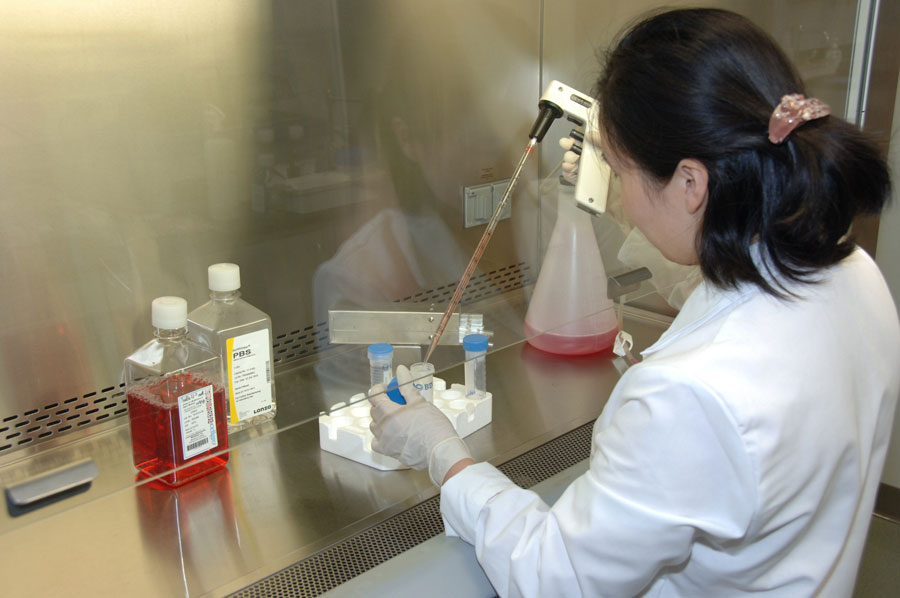New research lab opens at Marion duPont Scott Equine Medical Center

The Marion duPont Scott Equine Medical Center's advanced referral services and scientific research has always distinguished it as a leader in equine medical care.
Pioneering research conducted by equine medical center faculty members in the area of equine ulcers, equine protozoal myelitis, and musculoskeletal diseases, for example, has led to the development of commercial products.
But, the center’s growing stature as a research enterprise has taken a significant step forward with the construction of a major new laboratory, one that is equipped to explore the molecular aspects of disease and trauma. The research lab is expected to generate treatments that will improve health care — and not just for horses.
“Given the spaciousness of the lab, the equipment it holds, and the world-class expertise of the equine medical center faculty, the opening of this laboratory brings us onto the national stage in research,” noted Dr. Jennifer Barrett, an assistant professor of surgery at the facility. “And the results of our research here will not only make a critical difference in improving equine health, they could help improve the health of other animals — and possibly extend to improving human health,” she said.
“In addition,” Barrett continued, “this new lab offers a location for training future scientists. That’s an enormous benefit to the veterinary medical community.”
The 2,500-square-foot lab is set up for bench-top research, which includes growing stem cells for study and clinical application as well as identifying inflammatory proteins and molecules associated with numerous diseases and injuries. All of these methods are needed to help understand complex medical problems and to develop new treatments.
“One of our first projects focuses on tendon and ligament regeneration,” Barrett said. “This involves gathering adult stem cells from bone marrow as well as progenitor cells -- cells that are partially specialized -- from tendon. Because these tendon progenitor cells have some of the characteristics of stem cells and they are still in a form that is easily manipulated, they could be helpful in improving healing.
“Once we have progenitor cells, we subject them to various growth conditions,” Barrett continued. “We examine the results and decide which cells will provide new growth in an injured tendon.”
The application of this research will improve the ongoing use of stem cell injections to treat tendon and ligament injuries. “Specifically, we aim to reduce the turnover time for treating injuries and to optimize growth conditions of the cells prior to applying them to the injured area,” Barrett said. The overall goal is to help tendon and ligament heal quickly and effectively back to their original strength and elasticity.”
This is just one example of the research capabilities offered by the new laboratory. Other projects will involve isolating cells not only from bone marrow, but also from cartilage, fat, muscle, and tendon, then running tests to see how these cells perform under various conditions. In addition, researchers will be able to prepare platelet-rich plasma, which can then be used to treat both soft tissue and orthopedic injuries.
“Now with our in-house research capabilities, the cohesive, integrative approach we take at the [equine medical center] is greatly enhanced,” Barrett noted. “Our new cell and molecular research laboratory adds to our existing state-of-the-art facilities and equipment: a standing MRI, ultrasound equipment, a treadmill, video equipment, echocardiography, lasers, etc. Add to this our world-renowned faculty, and the result is that we are now operating at a new level in equine medical care,” she said.
The ability to incorporate new areas of research and testing in-house offers an array of benefits that all point to savings — in time, effort, and cost. “We can address clinical problems directly by conducting the appropriate tests in the lab, reporting the results, and bringing solutions to the patient — all in an incredibly efficient way,” said Dr. Martin Furr, the Adelaide C. Riggs Chair in Equine Medicine at the equine medical center. “With test results available more quickly, treatments may be started in a more timely way, which could lead to successful outcomes sooner,” he added.
“Fortunately,” Furr said, “we were able to fund this new lab through a variety of sources, including private donations, monies allocated from pari-mutuel activities, and through two of Virginia Tech’s Colleges: the Virginia-Maryland Regional College of Veterinary Medicine and the College of Agriculture and Life Sciences. Going forward, we will need to retain those funding sources, but also increase funding through grants offered by foundation or government agencies, or from private donors.
“Now that we have made this great stride,” Furr concluded, “we want to keep up the momentum.”




